![]()

U.S.
Department of Labor
Employment
& Training Administration

|
|

|
|
||||||||||||||||||||||||||||||||||||||||||||||||||||||||||
|
||||||||||||||||||||||||||||||||||||||||||||||||||||||||||
|
|
|
|
UI Benefit Accuracy Measurement Report for CY 2004 Calendar Year 2004 Benefit
Accuracy Measurement Data Summary
The Benefit Accuracy Measurement (BAM) program is designed to determine the accuracy of paid and denied claims in three major Unemployment Insurance (UI) programs: State UI, Unemployment Compensation for Federal Employees (UCFE), and Unemployment Compensation for Ex-Servicemembers (UCX). State Workforce Agencies select weekly random samples of UI payments and denied claims. BAM investigators audit these paid and denied claims to determine whether the claimant was properly paid or denied eligibility. The results of the BAM statistical samples are used to estimate accuracy rates for the populations of paid and denied claims. I. Paid Claims
Accuracy
Calendar year (CY) 2004 BAM paid claims results are based on the 24,709 sample cases completed by April 30, 2005, the date by which states were required to complete all CY 2004 BAM cases. This represents a completion rate of 99.9 percent. BAM auditors completed claimant interviews for approximately 90 percent of the cases. The remaining audits were completed based on information obtained from agency records, the claimants’ former employers, and third-party sources, such as labor unions and private employment agencies. UI benefit payments included in BAM in CY 2004 decreased to nearly $34.4 billion, compared with $41 billion in CY 2003. No single measure can reflect all aspects of UI benefit payment integrity. Four analytical measures have been developed, which are summarized in the following chart. 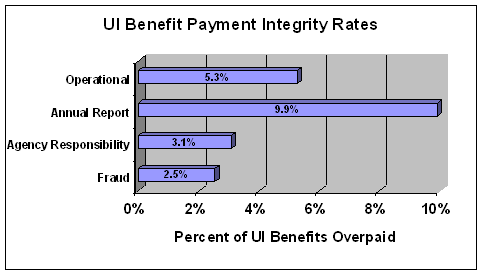
BAM Operational Rate (5.3%) - The BAM operational overpayment rate includes those overpayments that the states are reasonably expected to detect and establish for recovery -- fraud and nonfraud recoverable overpayments, excluding work search, employment service (ES) registration, base period wage issues and miscellaneous causes, such as benefits paid during a period of disqualification, redeterminations, and back pay awards. The operational rate is discussed in more detail below. BAM Annual Report Rate (9.9%) - The Annual Report rate includes fraud, nonfraud recoverable overpayments, nonfraud nonrecoverable overpayments, official action taken to reduce future benefits, and payments that are technically proper due to finality or other rules. All causes and responsible parties are included in this rate. Agency Responsibility (3.1%) - This rate includes overpayments for which the state agency was either solely responsible or shared responsibility with claimants, employers, or third parties, such as labor unions or private employment referral agencies. The rate includes fraud, nonfraud recoverable overpayments, nonfraud nonrecoverable overpayments, official action taken to reduce future benefits, and payments that are technically proper due to finality or other rules. Fraud (2.5%) - The definition of unemployment compensation fraud varies from state to state. The rate includes all causes and responsible parties.
BAM Operational
Rate
The BAM operational rate is a component of the performance indicator that measures the detection of recoverable overpayments, which is one of four UI goals for the Government Performance and Results Act (GPRA). These goals reflect the UI program's benefit payment, tax, and reemployment facilitation responsibilities. Additional information on the Employment and Training Administration's (ETA) goals can be found in the U. S. Department of Labor’s Strategic Plan for Fiscal Years 2003-2008 at http://www.dol.gov/_sec/stratplan/main.htm. This measure is also a core measure for UI Performs, the UI performance management system. The detection of overpayments measure is the percentage of recoverable, detectable overpayments estimated by BAM that state Benefit Payment Control (BPC) operations establish for recovery.
The operational rate represents that portion of total overpayments that state BPC operations should be able to detect and establish for recovery. The operational rate was defined following an extensive analysis of BAM overpayment data. The following charts show the three broad components of UI overpayments to illustrate the derivation of the operational rate. 1. Nonrecoverable Overpayments A little over one-fourth of the total amount of UI benefits overpaid in CY 2004 was unrecoverable. These overpayments consist of improper payments that cannot be recovered either because the time that has elapsed between the overpayment and its detection exceeds the period established in state law in which an erroneous payment can be recovered (finality rule) or responsibility for the improper payment error rests with the agency, employer, or third party, not the claimant. Employment Service (ES) registration and separation issues constitute the majority of this subgroup. 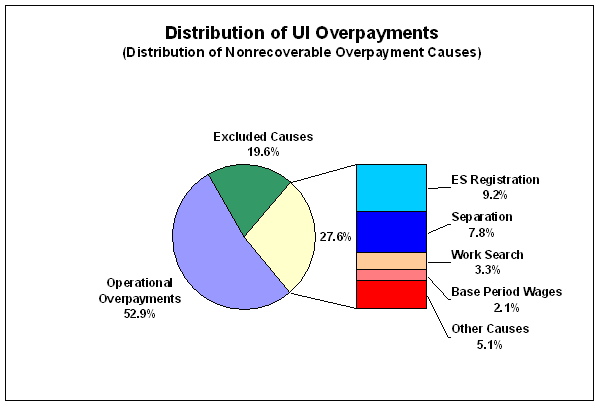
2. Fraud and Nonfraud Overpayments Excluded from the Operational Rate These overpayments consist of fraud and nonfraud recoverable overpayments that state agencies are unlikely to detect through the methods commonly employed by BPC (for example, crossmatches of UI claimant Social Security Numbers with wage record and New Hire Directory data, appeals reversals, and tips or leads). The cost of pursuing many of these overpayment errors exceeds the amount of benefits that can be recovered. Work search and base period wage issues constitute the majority of this subgroup, which includes around 20 percent of UI benefits overpaid in CY 2004. 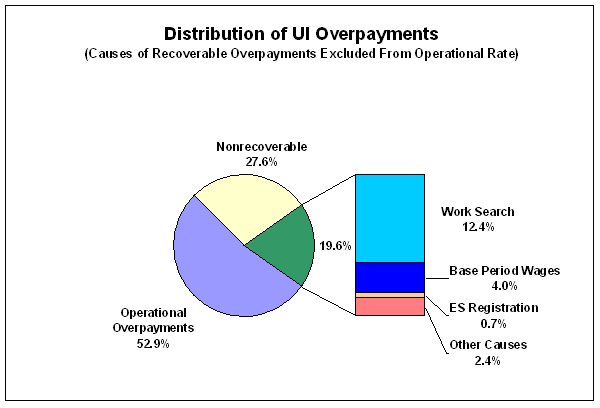
3. Operational Overpayments Overpayments included in the operational rate constitute over half of all UI benefits overpaid in CY 2004. After the exclusions described above, the remaining fraud and nonfraud recoverable overpayments meet the operational overpayment rate definition. More than half of the operational overpayments involve unreported or misreported benefit year earnings. Separation issues account for approximately one-fourth of the operational overpayments, followed by issues related to the claimant’s ability to work and availability for work (A & A). The "Other Eligibility" category includes refusal of suitable work, self-employment, alien status, identity theft, and reporting issues (failure to appear as requested by the state agency to provide information related to the UI claim). 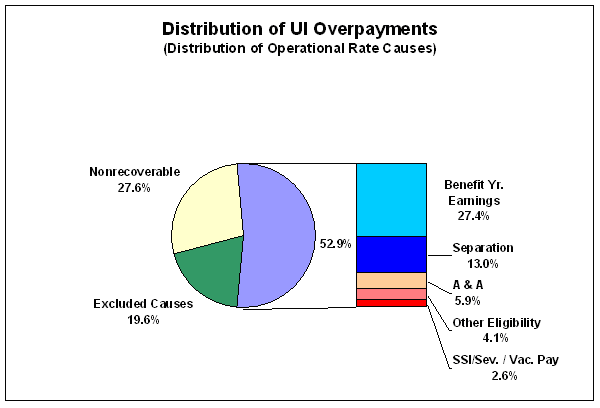
Overpayment Cause By Integrity Rate The distribution of the causes of UI overpayments varies considerably among the four integrity rates. For example, unreported or misreported benefit year earnings and income account for over 60 percent of UI fraud overpayments, over half (52 percent) of the overpayments defined by the operational rate, a little over a quarter (28 percent) of the overpayments included in the Annual Report rate, and slightly more than 5 percent of the amount overpaid for which the agency had full or partial responsibility. Separation issues are the second leading cause of UI overpayments included in the Annual Report rate, accounting for 21 percent of the amount overpaid, and are also the second leading cause of overpayments included in both the operational rate (accounting for one-quarter of the amount overpaid) and fraud overpayments (19 percent of the amount overpaid). However, separation issues are the leading cause of overpayments for which the agency had full or partial responsibility, accounting for almost one-third (32 percent) of the amount overpaid. By definition, work search and ES registration issues are excluded from the operational rate, and account for very small proportions of fraud overpayments. However, ES registration issues account for one-quarter of the amount overpaid for which the agency had full or partial responsibility, and approximately 10 percent of the amount overpaid included in the Annual Report rate. Work search issues are a significant cause for the broadest measure of overpayments, the Annual Report rate (16 percent), but are not a significant cause of either fraud overpayments (4 percent) or overpayments for which the agency had full or partial responsibility (6 percent). Able and available (A&A) issues account for 11 percent of the amount overpaid included in the operational rate, 6.5 percent of the amount overpaid included in the Annual Report rate, 6 percent of the fraud overpayments, and a little over 3 percent of the agency responsibility rate. 
Overpayment Responsibility By Integrity Rate As with cause, the distribution of overpayment responsibility varies considerably by integrity rate. Claimants alone were responsible for 58 percent of the dollars overpaid included in the Annual Report rate. Errors resulting in overpayments that were attributed exclusively to the state agency accounted for 15 percent of the amount overpaid, and the claimant and agency were jointly responsible for an additional 9 percent of the dollars that were overpaid. Claimants alone were responsible for 75 percent of the amount overpaid included in the operational rate, and the claimant and agency were jointly responsible for nearly 7 percent of the UI benefits overpaid under the operational rate definition. Claimants alone were responsible for 86 percent of the fraud overpayments, and claimants along with employers, agencies, or third parties were responsible for nearly all of the remainder. The agency rate is defined by responsible party. The agency was solely responsible for half of the amount overpaid included in this rate. Agencies shared responsibility with claimants, employers, or third parties for the remainder. 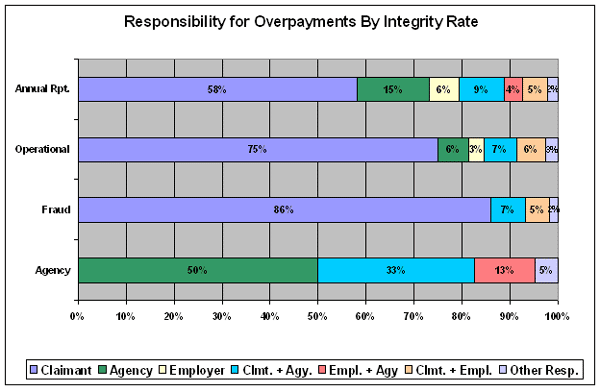
Prior Agency Action for UI Overpayments For all payment errors, BAM identifies the action that the state workforce agency took prior to the time that the payment was selected for the BAM sample. For all overpayments (Annual Report rate), a little over two-thirds of the amount of UI benefits that were overpaid were not detectable through normal agency procedures. For over one-fourth of the amount overpaid, the agency identified the overpayment issue but took the incorrect action (10 percent), had sufficient information but did not resolve the issue (9 percent), or did not follow procedures (8 percent). At the time BAM selected the sample, the agency had resolved or was in the process of resolving improper payments constituting 5 percent of the amount overpaid. More than three-fourths of the amount overpaid for those improper payments that are included in the operational overpayment rate was not detectable through normal agency procedures at the time the payment was made. At the time BAM selected the sample, the agency had resolved or was in the process of resolving improper payments constituting just under 8 percent of the amount overpaid. For the remainder of the operational overpayments, the agency had sufficient information to identify the overpayment issue but did not resolve the issue, identified the overpayment issue but took the incorrect action, or did not follow the prescribed procedures. Over 86 percent of the amount overpaid due to fraud was not detectable through normal agency procedures at the time the payment was made. The agency had resolved or was in the process of resolving improper payments constituting approximately 6 percent of the amount overpaid due to fraud. For overpayments for which the agency had full or partial responsibility, the agency had sufficient information to identify the overpayment issue but did not resolve the issue for 32 percent of the amount overpaid. The agency took the incorrect action for 31 percent of the amount overpaid and did not follow procedures for 26 percent of the amount overpaid. The remaining 10.5 percent of the amount overpaid for which the agency had full or partial responsibility either was not detectable through normal procedures at the time the payment was made or the agency had resolved or was in the process of resolving improper payments. 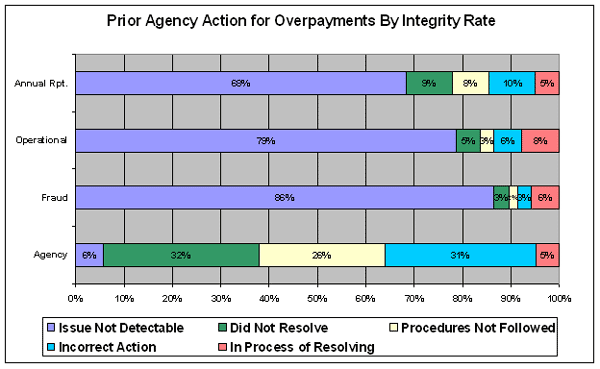
Dollar vs. Case Error Rates The previous analyses have focused on dollar error rates -- the percentage of UI benefits that were overpaid. Rates can also be estimated based on the number of UI payments (weeks of unemployment compensation that were paid). The following chart compares the dollar and case overpayment rates for the four integrity rate definitions. For example, while 9.9 percent of UI benefits were overpaid using the Annual Report definition, 17.6 percent of the 133.5 million UI payments included in the BAM survey population had overpayment errors. Just over 9 percent of UI payments were overpaid according to the operational rate definition, compared with 5.3 percent of the UI benefits paid. The difference in these rates is explained by the fact that many overpayments are partial overpayments -- that is, the claimant’s benefit is reduced, but not completely eliminated for the week claimed. This can occur, for example, if the claimant had some earnings during the week for which he or she received benefits, but these earnings were not large enough to completely disqualify the claimant for that week. The smaller the difference between the case and dollar overpayment rates, the fewer partial overpayments are included in the rate. For example, the fraud case error rate is 3.3 percent compared with the fraud dollar rate of 2.5 percent. Most fraud overpayments result in establishment of overpayments equal to the entire amount of the payment. 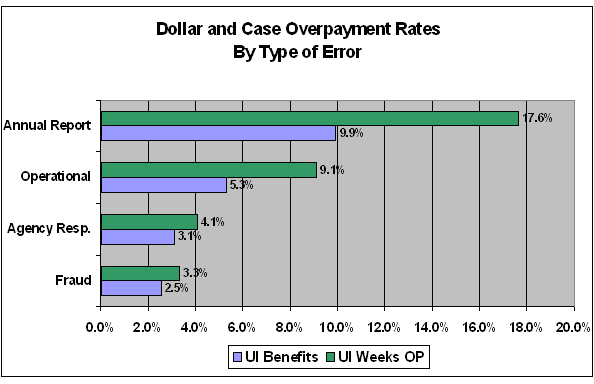
BAM Annual Report Overpayment Rate In Detail Additional analyses of the Annual Report overpayment rate are provided in Attachment 1, including overpayment causes, responsibility, state agency action, and rate changes. Underpayment Rates BAM estimates that $230 million were underpaid in CY 2004, compared with $237.1 million in CY 2003. As a percentage of UI benefits paid, the CY 2004 national underpayment rate of 0.67 percent is essentially unchanged from CY 2003. The underpayment rate decreased in 19 states in CY 2004, increased in 31 states, and was unchanged in 2 states.
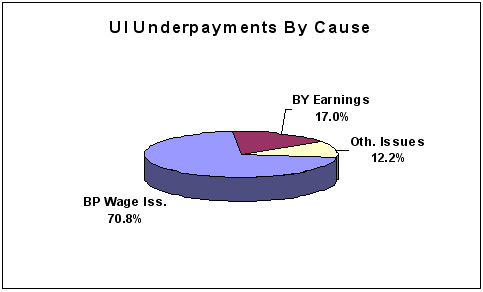
• Errors in reporting or recording base period wages accounted for over 70 percent of the amount underpaid and represented 0.47 percent of the amount of UI benefits paid in CY 2004. Errors in reporting or recording benefit year earnings were the second leading cause -- nearly 17 percent of all underpayments and 0.11 percent of UI benefits paid. 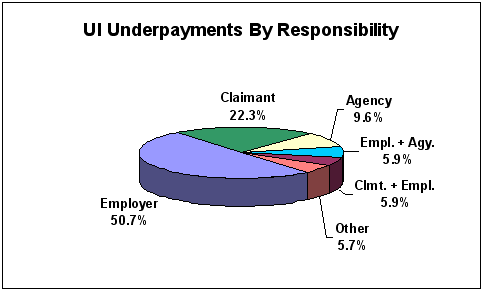
• Employers alone were responsible for just over half of the amount underpaid, which represented 0.34 percent of the amount of UI benefits paid. Claimants alone were responsible for an additional 22 percent of the amount underpaid, which represented 0.15 percent of the amount of UI benefits paid.
II. Denied Claims Accuracy (DCA) The underpayments estimated from BAM paid claims samples represent underpayments only for those claimants eligible for unemployment compensation (UC). Underpayments also result when claims for UC are erroneously denied. Each week, BAM units in the State Workforce Agencies select samples of denied UC claims from three populations, defined by the type of issue on which the denial was based -- monetary, separation, and nonseparation (continued eligibility). BAM estimated that 14.2 percent -- with an estimated sampling error of ± 0.8 percentage points (95 percent confidence interval) -- of the 1.2 million monetary denials in CY 2004 were improper. This represents an increase of 2.9 percentage points from the estimated improper monetary denial rate in CY 2003. These UI claims were denied because the agency had initially determined that the claimant had not earned sufficient wages in employment prior to being unemployed. The BAM DCA audit identified additional wage credits for these claimants that had not been included in the original monetary determination or identified errors in the original determination. For many of these improper denials, the state agency had identified the additional wages and issued a redetermination establishing eligibility independent of the BAM investigation or the initial denial was reversed on appeal. When the rate is adjusted for these redeterminations and appeals reversals, the improper denial rate for monetary determinations drops to 9.2 percent (with a 95 percent confidence interval ± 0.6 percentage points), a 2.3 percentage point increase from CY 2003. BAM estimated that 8.3 percent (with a 95 percent confidence interval ± 0.6 percentage points) of the 2.1 million separation denials issued in CY 2004 were improper, compared with 8.0 percent estimated for CY 2003. When redeterminations and appeals reversals are taken into account, the improper denial rate for separations decreases to 6.0 percent (± 0.5 percentage points), compared with 6.2 percent in CY 2003. The estimated improper denial rate of 11.8 percent (± 0.7 percentage points) for the 2.1 million nonseparation determinations in CY 2004 and the adjusted improper denials rate of 9.4 percent (± 0.6 percentage points) are unchanged from CY 2003. BAM determined that small percentages of the separation (0.3 percent) and nonseparation (1.9 percent) denials resulted in overpayments. Overpayments can occur if the period of disqualification for UI benefits was less than it should have been, and the claimant received compensation during the period that he or she should have been ineligible for benefits. Overpayments can also occur if the claimant received a partial payment that was too large. A partial payment is a reduction in the claimant’s weekly benefit amount and is issued when the claimant has earnings or other income for weeks that he or she claims UI benefits. For some of these compensated weeks, the BAM audit identified additional income that reduced benefits further or in some cases eliminated eligibility for benefits entirely. Small percentages of all three types of denials are classified as proper denials but for the wrong reason or section of the law. For example, a claimant may have been denied because of a monetary determination that the claimant had earned insufficient wages in the minimum number of weeks required by state law. The BAM audit determined that the claimant did meet the minimum weeks test, but was still ineligible due to insufficient total wage credits earned in the base period. For separation and nonseparation determinations, these errors typically involve citing the wrong issue in the determination (for example, availability versus reporting).
Notes: In several states the population from which the BAM DCA samples were selected may not include all of the determinations that meet the definition for inclusion in the DCA population. This limits the degree to which inferences about the population can be made from BAM DCA data. States are in the process of resolving these population issues. * Improper rate is the percentage of denied claims that BAM DCA concluded were erroneous, whether or not official agency action was taken to issue payment or increase claimant’s WBA, MBA or remaining balance. # Adjusted improper rate excludes erroneous denials that were corrected by the agency and claims for which eligibility was established on appeal prior to DCA case completion. + Properly denied, but for the wrong reason or section of the law.
Agency Action for Improper Denials Not every improper denial results in official action on the part of the agency to issue a payment to the claimant or to increase the claimant’s weekly benefit amount, maximum benefit amount, or dependents’ allowance. Agencies took action to insure that benefits were paid for approximately 80 percent of the improper monetary denials. However, only 34 percent of the claimants improperly denied for separation issues and 53 percent of the claimants improperly denied for nonseparation issues received benefits. In some cases the agency is precluded from taking action because of the time that has elapsed since the denial was issued (finality rules) or other by other provisions of the law. The following chart shows the classification of the type of error by type of denial, and shows the portion of improper denials for which the agency took official action. 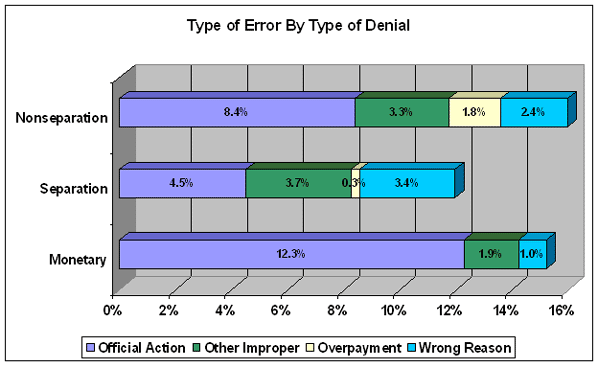
Responsibility for Improper Denials The party responsible for erroneous denials varies by type of denial determination. Employers were solely responsible for 31 percent of the erroneous monetary denials due to misreporting or underreporting employees’ wages. Agency error accounted for 26 percent of the improper monetary denials, and employers and state agencies were jointly responsible for another 10 percent of the erroneous monetary denials. The state agencies were solely responsible for the 55 percent of the incorrect separation denials and 46 percent of the improper nonseparation denials. Employers and the state agencies were jointly responsible for 19 percent of the erroneous separation denials. Claimants were responsible for nearly a quarter of the erroneous nonseparation denials. 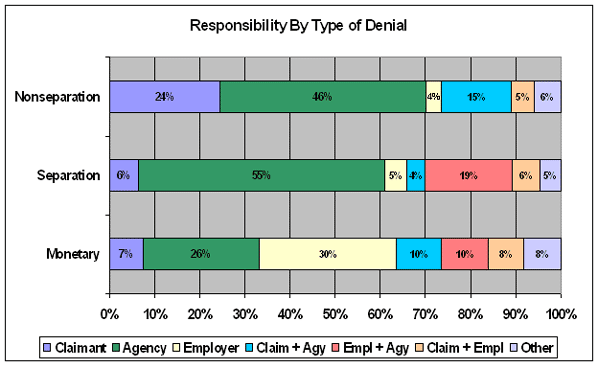
Prior Agency Action for Improper Denials Because the state agencies are responsible for the majority of the erroneous nonmonetary denials and for a significant proportion of the monetary denials, it is instructive to examine agency action prior to the DCA investigation. Agencies had resolved or were in the process of resolving nearly one-third of the erroneous monetary denials. Another third of the improper monetary denials could not be detected through the normal claims taking procedures. Typically, these are claims for which the employer incorrectly reported the wages. For improper nonmonetary denials, the agency identified the issue but took the incorrect action for 60 percent of the improper separation determinations and 42 percent of the erroneous nonsepartion determinations. Although the agency followed its procedures, the issue or information was undetectable for 16 percent of the improper separation determinations and 29 percent of the erroneous nonsepartion determinations. That is, the agency issued its determination to deny eligibility based on information that, although incomplete, was the best available under normal procedures at the time of its decision. 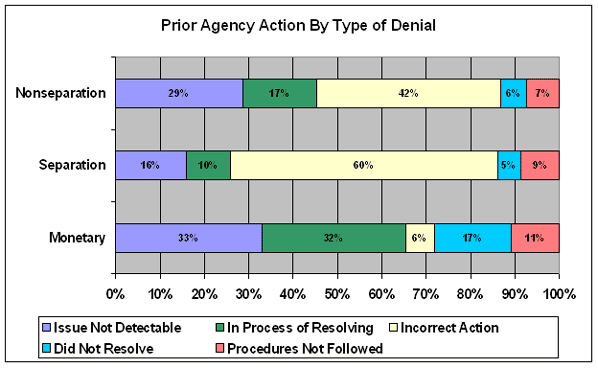
Separation Issues 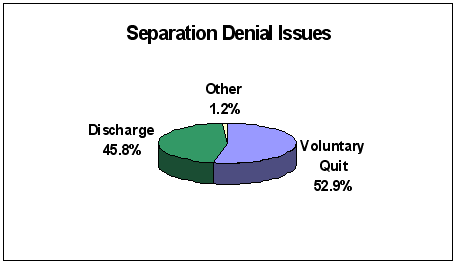
A majority of the separation denials concerned voluntary quits, while discharges accounted for most of the balance. "Other" includes a small number of labor disputes, military separations, or claimants who were still job attached (partial unemployment).
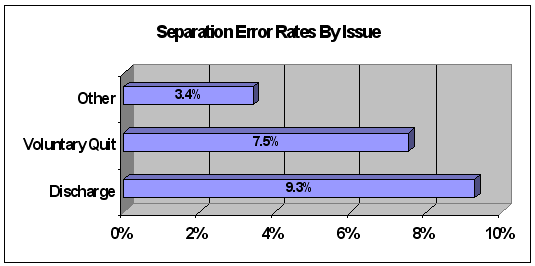
Claims that were denied for discharge issues were somewhat more likely to be in error than denials issued for voluntary quits (VQ). Over nine percent of discharge denials were improper, compared with 7.5 percent of the VQ denials. Only 3 percent of the separation denials that were based on "Other" issues were incorrect.
Nonseparation Issues 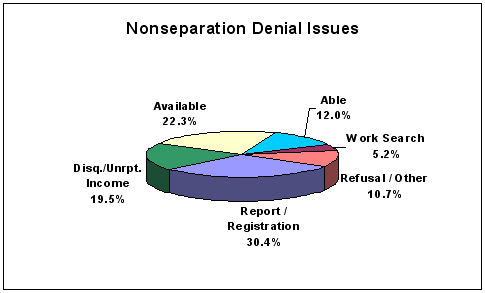
The largest single nonseparation issue in CY 2004 was the claimant’s failure to report as required by the state agency to provide information related to the UI claim or to receive reemployment services. The remaining nonseparation denials are distributed among several issues, with able and available issues and disqualifying or unreported income issues collectively comprising the majority.
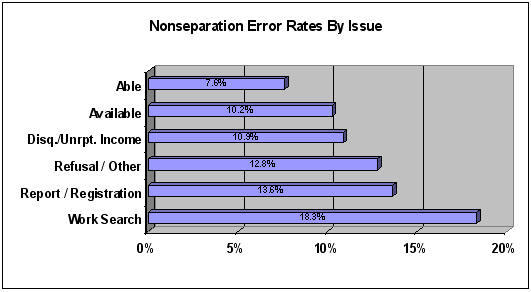
Denials based on the claimant’s ability to work had the lowest error rate (7.6 percent). Determinations that denied eligibility because the claimant failed to meet the state’s work search requirements had the highest error rate (18.3 percent), although work search issues constitute only 5 percent on the nonseparation denials.
Denials and UI Workload Measures Monetary Denials It is useful to examine denials in the context of the UI claims workload. For example, state workforce agencies determine the monetary eligibility of claimants when they file a new initial claim or a transitional claim.* In CY 2004, there were 11.8 million new initial claims and just over 700 thousand transitional claims. State agencies determined that nearly 88 percent of these new initial and transitional claims were monetarily eligible. An additional 10.3 percent of these claims were properly denied. Only 1.7 percent of these claims were improperly denied, and agencies had corrected or were in the process of correcting approximately 35 percent of these improperly denied claims. 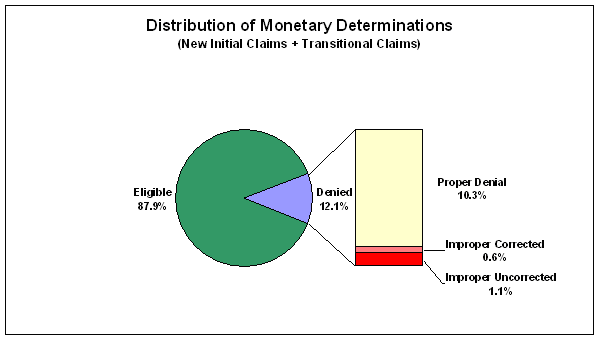
* A transitional claim is a claim filed to request a determination of eligibility and establishment of a new benefit year having an effective date within the seven-day period immediately following the benefit year ending date and a week for which compensation or waiting week credit was claimed. Separation Denials In order to be eligible for unemployment compensation, a claimant must be involuntarily unemployed through no fault of their own -- that is, the claimant is unemployed due to lack of work. Agencies conduct determinations of eligibility when a separation issue has been identified. For example, the claimant’s separating employer may assert that the UI claimant quit voluntarily or was discharged for good cause. The agency then gathers information from the claimant, employer, and relevant third parties and issues a determination of eligibility. Separation issues normally are identified when a new initial claim or an additional claim+ is filed. In CY 2004, there were approximately 10.4 million monetarily eligible new initial claims and approximately 6.4 million additional claims. No separation determination was required for three-fourths of these claims, because the claimant and employer agreed that the reason for separation was lack of work. State agencies conducted separation determinations and determined that 12.5 percent of these monetarily eligible new initial claims and additional claims were filed by claimants who were unemployed due to lack of work and were therefore eligible to file claims for individual weeks of unemployment. An additional 12 percent of these claims were properly denied. A little over one percent of all monetarily eligible new initial claims and additional claims were improperly denied, and agencies had corrected or were in the process of correcting a little more than 25 percent of these. 
+ Additional claims are filed when a claimant returns to work during the benefit year before exhausting the maximum amount of UI benefits to which he or she is entitled, is separated from that employment, and files a claim for additional weeks of unemployment. The agency determines eligibility based on the circumstances of the claimant’s separation from the intervening employment. Nonseparation Denials Nonseparation issues include the claimant’s ability to work and availability for work, disqualifying and unreported earnings and income during the benefit year, failure to meet work search requirements, and failure to report as required by the state agency to provide information related to the UI claim or to receive reemployment services. Some of these issues are detected when the claimant files a new initial or an additional claim, and some are identified during the benefit year when a claimant files a continued claim for UI. Because nonseparation issues can be detected at various points in the claims taking process, it is difficult to identify an appropriate analytical workload measure. In CY 2004 state agencies conducted 3.4 million nonseparation determinations. This represents only 2 percent of the 156.2 million UI weeks claimed and 2.5 percent of UI weeks paid. However, an alternative workload measure for analytical purposes is the number of monetarily eligible new initial claims minus those claimants denied for separation issues. The eligibility of these approximately 9 million claimants is potentially affected by nonseparation issues. For each UI payment selected for BAM, investigators code the number of nonseparation determinations conducted by the state workforce agency prior to the sampled payment. Based on these data (weighted to represent claimants rather than UI weeks) an estimated 80 percent of claimants eligible to claim weeks of UI had no nonseparation determination, and an additional 5.8 percent were determined to be eligible for UI benefits after a nonseparation issue had been adjudicated. The proper denial rate for this group was approximately 12 percent, and the rate of improper denials that were not corrected by the agency through either redetermination or appeal was 1.3 percent. 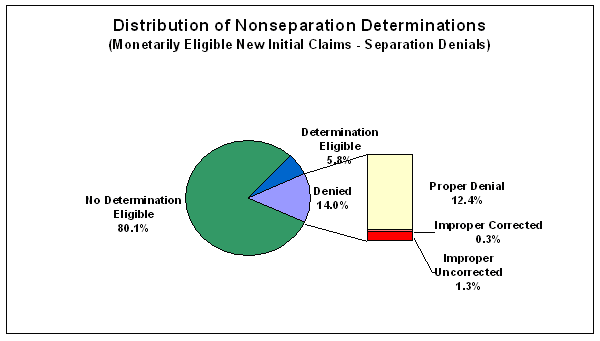
Links to Additional BAM Paid and Denied Claims Data and BAM Methodology
Prepared by: |
|
||
|
|
||